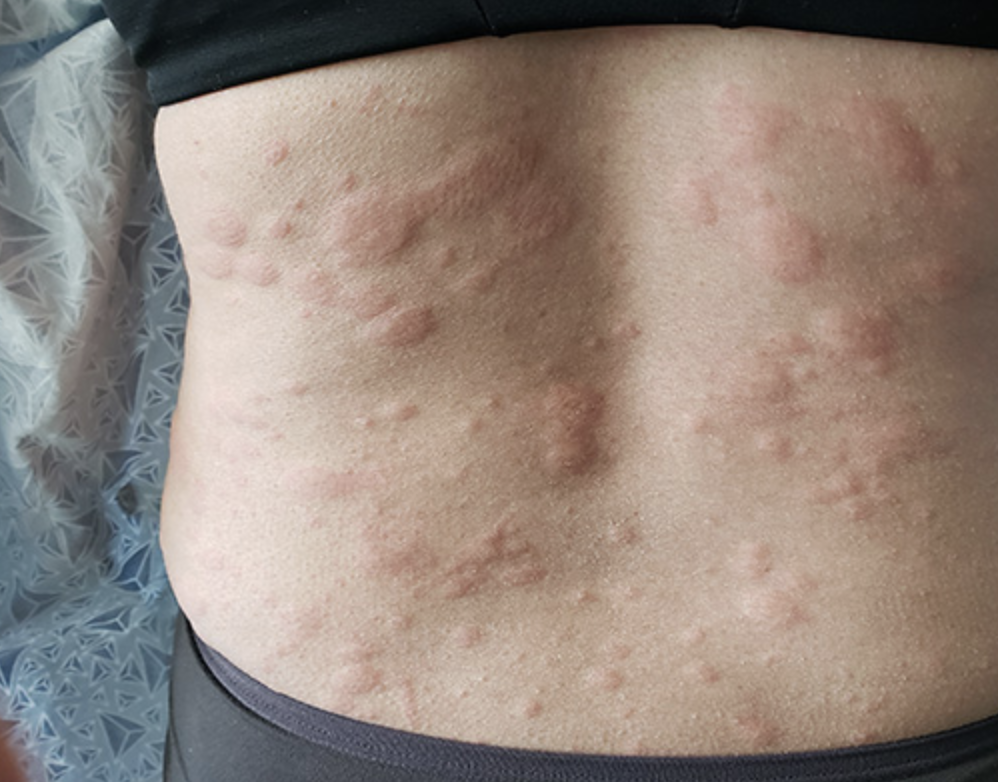What is urticaria?
Urticaria (pronounced ur·tuh·keh·ree·uh) is another word for hives. It’s estimated that 20 percent of people in the United States will develop hives – an itchy skin rash accompanied by raised, red welts or spots – at some point in their lives. The development of hives is often related to an allergic reaction, usually to food, latex or insect venom.
What is chronic idiopathic urticaria (CIU)?
Some people develop hives in which symptoms come and go for six or more weeks. These are known as chronic hives or chronic urticaria.
Sometimes you and your doctor are unable to identify what’s causing your hives to keep coming back. Often the hives can occur on different parts of the body. When this happens, the hives are called chronic idiopathic urticaria (CIU). Idiopathic means “of unknown cause.”
Another name for CIU is chronic spontaneous urticaria (CSU).
CIU outbreaks can appear at any time without triggers. Chronic urticaria is not contagious. The symptoms of CIU are not life-threatening, but, CIU can cause extreme discomfort and greatly impact quality of life.
How common is CIU?
CIU affects approximately 1.6 million people in the United States. CIU most often occurs in people between the ages of 20 and 40. Women are twice as likely to have CIU than men.
What causes CIU?
CIU is thought to be an immune system response. For this reason, it is best to see a board certified allergist trained in immunology
How is chronic idiopathic urticaria diagnosed?
When you and your doctor are unable to identify what’s causing your chronic hives, it’s likely chronic idiopathic urticaria.
On your first visit to the doctor, you may be asked the following questions to try to pinpoint what’s causing the hives:
- When and where on the body do hives occur?
- Is there any swelling?
- How long do symptoms last?
- What were you doing at the time hives occurred?
- What medications (if any) are you taking?
- Are there any other symptoms?
A blood test can help with diagnosis since blood cells in CIU patients often manufacture enormous amounts of histamine.
Your doctor will also ask what foods you were eating at the time of symptoms to determine if a food allergen caused your hives.
How is chronic idiopathic urticaria treated?
CIU is not a life-long condition; it usually goes away by itself over a period of days, weeks or months. Meantime, doctors and patients work together to find the most appropriate treatment and symptom management strategy.
CIU guidelines recommend a step-based approach to treatment, starting with over-the-counter antihistamines, preferably non-sedating ones. (Since CIU is a whole body condition, topical skin creams are not considered a treatment.)
If that doesn’t help, then H2 blockers are the next step. These block production of the histamine that causes hives. Doctors might also consider montelukast, which blocks leukotrienes, a chemical involved in inflammation.
Another consideration is omalizumab, an anti-IgE biologic given by injection (usually once a month) to block IgE antibodies involved in the production of histamine.
What are the impacts of chronic idiopathic urticaria on quality of life?
While the physical burden of CIU is significant, it is important to understand the impact CIU can have on your quality of life. Some people with CIU describe the random episodes of extremely itchy or painful skin as feeling like a poison ivy sensation or wanting to scratch their skin off. These symptoms can leave those dealing with CIU in pain and fatigued. It can cause one to have difficulty sleeping. Many people develop anxiety and depression as well.
People with CIU are often frustrated by the unknown nature of this disease. They may also feel socially stigmatized as their skin may look “diseased,” which may cause them to avoid social situations. The costs of healthcare for CIU as well as loss of work productivity further add to the burden.
A 2017 study1 identified different stages of the journey for patients living with chronic idiopathic urticaria.
- The first stage is the crisis stage where symptoms develop, and the patient often experiences feelings of torment, disorientation and shock due to the nature of the symptoms.
- The next phase involves searching for answers as patients begin making repeat visits to doctors and even doing their own research.
- The third phase is when the condition is diagnosed, which may provide some hope and relief, and patients begin to connect with others who have Despite a definitive diagnosis, patients still experience anxiety and struggle with the unknown cause of their disease.
- The last phase involves disease management in which patients learn to live with the disease –but this is often a mixed bag because it can depend on how effective the treatment is and if there are recurrent symptoms.
What can healthcare professionals do to be most helpful to people dealing with chronic idiopathic urticaria?
As people begin to deal with CIU, it is important for your healthcare professional to listen and understand people’s experiences and recognize different phases of their journey. CIU patients need to feel that their doctors are taking them seriously, involve them in planning treatment and acknowledge how this disease affects their quality of life.
Ongoing research into the psychosocial impacts of CIU will help bridge gaps in care and assure that the needs of CIU patients are addressed more comprehensively.
© 2021 Allergy and Asthma Network

Last updated : 12/12/2020